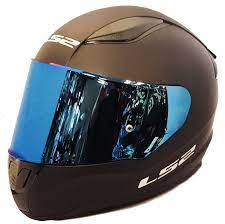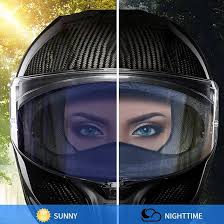
Tinted Motorcycle Visor: Enhancing Style and Protection
When it comes to riding motorcycles, safety is of utmost importance. A crucial component of a rider’s protective gear is the helmet, which shields the head from potential injuries. Within the helmet, the visor plays a vital role in protecting the eyes from wind, debris, and harmful UV rays. While clear visors are the standard choice for most riders, tinted motorcycle visors have gained popularity for their unique benefits.
First and foremost, tinted visors offer enhanced protection against bright sunlight. Riding on a sunny day can be exhilarating, but it can also be blinding at times. A tinted visor acts as a shield against excessive glare and harmful UV rays, ensuring clear visibility while keeping your eyes comfortable and protected.
Moreover, tinted visors provide an added layer of privacy. They limit the view from outside into your helmet, giving you a sense of anonymity while riding through busy streets or crowded areas. This extra privacy can be particularly appealing for those who value their personal space or prefer to ride discreetly.
In addition to their functional advantages, tinted visors also add a touch of style to your riding gear. They come in various shades and colours that allow you to express your personality and create a unique look. Whether you prefer a sleek black tint or a bold mirrored finish, there is a tinted visor option to match your individual style.
However, it’s important to note that using tinted visors requires careful consideration of lighting conditions. While they excel in blocking excessive sunlight during the day, they may reduce visibility in low-light situations or at night. Therefore, it’s crucial to choose a tint level that suits your riding preferences and adapt accordingly when lighting conditions change.
When selecting a tinted motorcycle visor, ensure that it meets safety standards and regulations set by relevant authorities in your region. Look for certifications such as the ECE 22.05 mark, which guarantees that the visor meets European safety standards. Prioritizing safety and quality will ensure that you enjoy the benefits of a tinted visor without compromising on protection.
In conclusion, tinted motorcycle visors offer a blend of style and functionality for riders seeking enhanced eye protection. They shield your eyes from bright sunlight, provide added privacy, and allow you to express your personal style. However, it’s essential to choose the right tint level for different lighting conditions and ensure compliance with safety standards. With a tinted visor, you can ride with confidence, knowing that you have an extra layer of protection while adding a touch of individuality to your riding gear.
Frequently Asked Questions About Tinted Motorcycle Visors in the UK
- Are tinted motorcycle visors legal?
- Can I use a tinted visor at night?
- What are the different shades of tint available for motorcycle visors?
- How do I choose the right tint level for my riding needs?
- Do tinted visors provide UV protection?
- Can I replace the clear visor on my helmet with a tinted one?
- How do I clean and maintain a tinted motorcycle visor?
- Are there any safety standards or certifications to look for when purchasing a tinted visor?
Are tinted motorcycle visors legal?
The legality of tinted motorcycle visors can vary depending on the specific regulations set by each country or region. In some places, there are restrictions on the level of tint allowed for motorcycle visors, while in others, they may be completely prohibited. It is crucial for riders to familiarize themselves with the local laws and regulations regarding tinted visors before using them.
In certain jurisdictions, there may be specific requirements for visibility and light transmission that must be met by motorcycle visors. These regulations are in place to ensure that riders have sufficient visibility while riding, especially during low-light conditions or at night. Tinted visors that do not meet these requirements may be considered illegal and could result in penalties if used.
To determine the legality of tinted motorcycle visors in your area, it is advisable to consult local traffic regulations or contact relevant authorities such as transportation departments or law enforcement agencies. They will provide accurate information regarding the permissible level of tint and any other restrictions applicable to motorcycle visors.
Remember that prioritizing safety should always be a top concern when choosing any gear for riding motorcycles. If you are unsure about the legality of tinted visors or have concerns about their impact on visibility, it is recommended to opt for clear visors that comply with all safety standards and regulations. Clear visors offer optimal clarity and ensure unobstructed vision while riding.
Ultimately, it is essential to abide by local laws and regulations to ensure both your safety and legal compliance while enjoying your motorcycle rides.
Can I use a tinted visor at night?
Using a tinted visor at night is not recommended. Tinted visors are primarily designed for daytime use, as they are intended to reduce glare and protect the eyes from bright sunlight. The tinting can significantly reduce visibility in low-light conditions, making it difficult to see clearly at night.
When riding in the dark or during periods of low visibility, it’s crucial to prioritize safety and opt for a clear visor that provides maximum visibility. Clear visors allow for better light transmission, ensuring that you can see the road and potential hazards clearly.
It’s important to follow local regulations and safety guidelines regarding helmet visors. In many jurisdictions, it is mandatory to have a clear visor or wear appropriate eyewear when riding at night. Always check the specific laws and regulations in your area to ensure compliance and promote safe riding practices.
Remember, your safety should always be the top priority when enjoying your motorcycle rides.
What are the different shades of tint available for motorcycle visors?
Motorcycle visors come in a range of tint shades to cater to different lighting conditions and personal preferences. Here are some commonly available shades:
- Light Smoke: This is a subtle tint that offers a slight reduction in brightness without significantly affecting visibility. It is suitable for daytime riding in moderate sunlight.
- Dark Smoke: A darker shade than light smoke, dark smoke visors provide increased protection against bright sunlight and glare. They are ideal for riding on sunny days but may reduce visibility in low-light conditions.
- Mirrored: Mirrored visors have a reflective coating that not only provides excellent sun protection but also adds a stylish look to your helmet. They are often available in various colours, such as silver, blue, or gold.
- Iridium: Similar to mirrored visors, iridium visors feature a reflective coating with a distinct rainbow-like effect. They offer enhanced sun protection and add an eye-catching aesthetic to your helmet.
- Photochromic: Photochromic visors have the ability to automatically adjust their tint level based on the surrounding light conditions. They darken when exposed to bright sunlight and lighten when entering darker environments, providing optimal visibility throughout the day.
- Clear with Tinted Strip: Some riders prefer clear visors with a tinted strip at the top or bottom of the visor. This design allows for maximum visibility while still providing some sun protection by blocking direct sunlight from entering through the strip area.
It’s important to note that the availability of specific tint shades may vary depending on the brand and model of motorcycle visor you choose. Additionally, it’s essential to check local regulations regarding permissible tint levels for motorcycle helmets in your region before making a purchase.
Remember, selecting the right tint shade depends on your personal preference and riding conditions, so choose one that suits your needs while ensuring optimal visibility and safety on the road.
How do I choose the right tint level for my riding needs?
Choosing the right tint level for your riding needs requires considering various factors, such as lighting conditions, personal preferences, and legal requirements. Here are some guidelines to help you make an informed decision:
- Legal regulations: Check the local regulations regarding tinted visors in your region. Different jurisdictions may have specific rules on permissible tint levels. Ensure that the tint level you choose complies with these regulations to avoid any legal issues.
- Lighting conditions: Consider the typical lighting conditions in which you ride. If you primarily ride during bright and sunny days, a darker tint may be suitable to provide optimal protection against glare and UV rays. However, if you frequently ride in low-light situations or at night, a lighter tint or a clear visor would be more appropriate to maintain good visibility.
- Personal preference: Think about your personal comfort and visual preferences. Some riders prefer a darker tint for a more aggressive look or increased privacy, while others may prefer a lighter or medium tint for a balance between sun protection and visibility. Consider trying out different tint levels to see which one feels most comfortable for you.
- Test rides: If possible, try borrowing or renting helmets with different tint levels to test them out in various lighting conditions before making a purchase. This will give you firsthand experience of how each tint level affects your visibility and overall riding experience.
- Transitional options: Another alternative is considering transitional visors that automatically adjust their tint based on lighting conditions. These visors darken when exposed to bright sunlight and lighten when entering shaded areas or at night. They offer versatility by adapting to changing light levels without requiring manual changes.
Remember that choosing the right tint level is subjective and depends on individual preferences and riding conditions. It’s essential to prioritize safety by ensuring good visibility while protecting your eyes from excessive sunlight. Take into account legal requirements, test different options if possible, and select a tint level that provides optimal comfort and protection for your riding needs.
Do tinted visors provide UV protection?
Yes, tinted visors do provide UV protection. The tinted coating on the visor blocks a significant amount of harmful ultraviolet (UV) rays from reaching your eyes. This is particularly beneficial when riding in bright sunlight for extended periods as it helps to reduce the risk of eye strain and potential damage caused by prolonged exposure to UV rays.
However, it’s important to note that the level of UV protection provided by tinted visors can vary depending on the specific brand, type, and darkness of the tint. When purchasing a tinted visor, it’s advisable to look for those that explicitly mention UV protection or have certifications indicating their ability to block harmful UV rays.
To ensure maximum eye safety and protection against UV rays, it is still recommended to wear sunglasses with appropriate UV filters under your helmet, especially if you are riding in extremely bright conditions or have sensitive eyes. This will provide an extra layer of protection and minimize any potential risks associated with prolonged exposure to sunlight while riding.
Can I replace the clear visor on my helmet with a tinted one?
Yes, in most cases, you can replace the clear visor on your helmet with a tinted one. Many helmet manufacturers offer interchangeable visors, allowing riders to customize their gear based on their preferences and riding conditions.
To replace the visor, follow these general steps:
- Check your helmet’s user manual: Before attempting any modifications, consult your helmet’s user manual to ensure that it supports interchangeable visors and provides specific instructions for replacing them.
- Remove the clear visor: Most helmets have a quick-release mechanism or a specific method for removing the visor. Refer to your helmet’s manual for detailed instructions on how to detach the clear visor safely.
- Install the tinted visor: Once you have removed the clear visor, carefully align the mounting points of the tinted visor with those on your helmet. Follow the manufacturer’s instructions to securely attach and lock the new visor in place.
- Test functionality: After installing the tinted visor, perform a quick check to ensure that it operates smoothly and securely. Open and close it a few times to verify that it functions correctly without any obstructions or loose parts.
Remember, different helmets may have varying mechanisms for attaching and detaching visors, so always refer to your specific helmet’s manual for accurate instructions. Additionally, make sure that any replacement tinted visor you choose meets safety standards and regulations set by relevant authorities in your region.
By replacing your clear visor with a tinted one, you can enjoy enhanced protection against sunlight while adding a touch of style to your riding gear. Ride safely and confidently with your new tinted motorcycle visor!
How do I clean and maintain a tinted motorcycle visor?
Proper cleaning and maintenance of your tinted motorcycle visor are essential to ensure its longevity and optimal performance. Here are some steps to follow:
- Gather the necessary supplies: You will need a soft microfiber cloth, mild soap or visor cleaner specifically designed for motorcycle helmets, and warm water.
- Remove the visor from your helmet: Most visors can be easily detached from the helmet using a quick-release mechanism or screws, depending on the model. Follow the manufacturer’s instructions for safe removal.
- Rinse off loose debris: Hold the visor under warm running water to remove any loose dirt or debris. Be gentle and avoid using excessive force to prevent scratching the surface.
- Clean with mild soap or visor cleaner: Apply a small amount of mild soap or specialized visor cleaner to your microfiber cloth. Gently wipe both sides of the visor in a circular motion, paying attention to any stubborn stains or bugs that may have accumulated.
- Rinse thoroughly: Once you have cleaned both sides of the visor, rinse it under warm water again to remove any residue from the soap or cleaner.
- Dry gently: Pat dry the visor with a clean, dry microfiber cloth. Avoid using paper towels or rough materials that could scratch the surface.
- Reattach the visor: Once completely dry, carefully reattach the visor to your helmet according to the manufacturer’s instructions.
- Store properly: When not in use, store your tinted visor in a protective bag or case specifically designed for helmet accessories. This will prevent scratches and keep it in good condition until your next ride.
Additional tips:
– Avoid using harsh chemicals, solvents, or abrasive cleaners as they can damage the tinted coating on your visor.
– If you encounter stubborn stains that won’t come off with regular cleaning, try using specialized anti-fog solutions or seek professional assistance.
– Regularly inspect your visor for any signs of damage or wear. If you notice cracks, deep scratches, or compromised visibility, it’s best to replace the visor for your safety.
By following these cleaning and maintenance steps, you can keep your tinted motorcycle visor clean, clear, and in optimal condition for a safe and enjoyable riding experience.
Are there any safety standards or certifications to look for when purchasing a tinted visor?
Yes, there are safety standards and certifications that you should look for when purchasing a tinted visor for your motorcycle helmet. These standards ensure that the visor meets specific requirements for safety and performance. The most common certification to look for is the ECE 22.05 mark.
The ECE 22.05 standard is a European safety standard that applies to motorcycle helmets and their visors. It sets out regulations regarding impact resistance, optical quality, field of vision, and other important factors. When a visor carries the ECE 22.05 mark, it means that it has been tested and approved to meet these stringent safety standards.
It’s important to note that different countries may have their own safety standards or certifications specific to motorcycle visors. For example, in the United States, the Department of Transportation (DOT) certification is commonly used as an indicator of a helmet’s safety compliance. While DOT certification primarily focuses on helmets, some manufacturers may also include DOT-certified tinted visors as part of their offerings.
When purchasing a tinted visor, always check if it meets the relevant safety standards in your region or country. Look for labels or markings indicating compliance with recognized certifications like ECE 22.05 or DOT. These certifications provide assurance that the tinted visor has undergone rigorous testing and meets the necessary safety requirements.
Remember, prioritizing safety is crucial when selecting any motorcycle gear, including tinted visors. By choosing certified products that comply with established safety standards, you can ride with confidence knowing that your eyes are protected without compromising on quality or performance.



